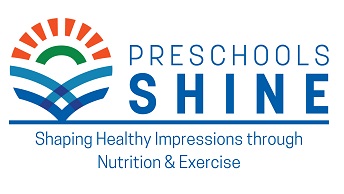SHINE Element 3: Mealtime Environment
Overview
Guidance for implementing the criteria for Element 3, Mealtime Environment, of the Preschools Shaping Healthy Impressions through Nutrition and Exercise (SHINE) program.
Criteria for Element 3, Mealtime Environment
- Serve a minimum of one meal or snack family-style each day.
- Provide children with adequate time to eat a meal or snack.
- Practice Ellyn Satter’s Division of Responsibility in Feeding principles.
- Follow mealtime environment best practices.
Follow the practices below to meet the criteria for Element 3
- Serve a minimum of one meal or snack family-style each day
Family-style meal service is preferred in child care settings if local health and safety guidelines permit. Family-style mealtimes allow children and adults to enjoy a meal or snack together. At the table, children eat familiar and favorite foods; experiment with tasting new foods, flavors, and textures; exchange conversation; build motor skills; and learn how to regulate food intake. With adults seated at the table, mealtimes become an important teaching opportunity.
- Provide adequate space and clean, pleasant surroundings.
- Provide eating and serving utensils that are easily handled by young children.
- Place all the Child and Adult Care Food Program meal components on the table, where children serve themselves from common dishes of food.
- Cut food into bite-size pieces, when appropriate, to make food manageable for young children to eat. Support young children’s emerging eating skills and provide assistance when necessary.
- Role model healthy eating by sitting with children and eating the same meal that the children eat.
- Provide encouragement and make positive comments about the meals and snacks served.
- Avoid the expression of negative remarks or body language.
- Teach social skills and practice good table manners.
- Handle children’s challenging behaviors with patience and sensitivity.
- Talk about nutrition and the food that everyone is enjoying together.
- Ensure that children who need help are seated near an adult.
To learn how to make family-style mealtimes successful at the program site, access Eat Family Style Toolkit created by the Nebraska Department of Education available on the Child Nutrition Sharing Site.
- Provide children with adequate time to eat a meal or snack
Mealtimes should not feel hurried. Good judgment is needed. Generally, 20–30 minutes is enough time for children to enjoy a meal; however, adjust time according to the needs of the children.
- Practice Ellyn Satter’s Division of Responsibility in Feeding principles
Ellyn Satter’s Division of Responsibility in Feeding principles encourages adults to take leadership with the what, when, and where of feeding, while children determine how much and whether to eat what the adult provides.
- Adult responsibilities:
- Choose and prepare healthy food.
- Offer meals and snacks at set times throughout the day and do not allow food or beverages (except for water) between meal and snack times.
- Make eating times pleasant.
- Child responsibilities:
- Eat the amount needed to feel satiated.
- Behave well at mealtime.
For more information about Ellyn Satter's Division of Responsibility in Feeding principles, view the CDSS Division of Responsibility in Feeding tip sheet available in English and Spanish or access the Ellyn Satter Raise a Healthy Child Who is a Joy to Feed web page.
- Follow mealtime environment best practices:
- Do not require children to eat everything on their plates or praise them for finishing their food or cleaning their plates. This may lead to overeating and childhood obesity.
- Help children determine hunger and fullness by encouraging appropriate portion sizes for small children’s stomachs and asking children if they are hungry before offering a second helping.
- Avoid disciplining or scolding children during mealtime.
- Do not use food as a reward or punishment.
- Do not compare differences or preferences for food between children.
- Never discuss a child’s body size or shape.
- Do not allow screen-time viewing during meals and snacks.
For additional information on creating an optimal mealtime environment, access the Healthy Kids, Healthy Future website, select the green Improve Food Choices icon, then select the Best Practices for Health Eating guide link.

This institution is an equal opportunity provider.
Esta institución es un proveedor que ofrece igualdad de oportunidades.